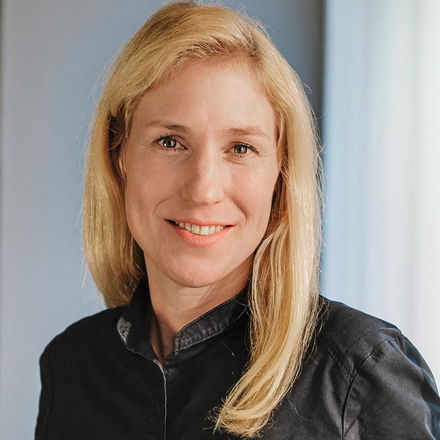If you want to find out how people tick, ask them about their role models. All of the employees at Evonik Digital GmbH have put up posters of their role models in the company kitchenette. Captain Future is there next to Catwoman, and Mr. Spock rubs shoulders with Tesla founder Elon Musk. The role models include superheroes, science fiction characters, and visionaries who are pushing the envelope, taking on challenges, and changing the world with their ideas.
The process engineer Henrik Hahn, 49, doesn’t look like Captain Future or Mr. Spock. He is Evonik’s first Chief Digital Officer and the men and women who work at this subsidiary form his team. Together, they want to discover the Group’s digital potential and use their ideas to set standards for the chemical sector. Rather surprisingly, they are doing this in a former savings bank.
This unadorned building is located on an ordinary street, with an old pub just around the corner. Are Hahn and his team really trying to shape Evonik’s digital future here? “We needed a spatial concept that would foster innovation and communication and generate a real startup feeling,” Hahn explains. The people who work here don’t use their last names or insist on their academic titles. They work in open-plan offices instead of separate rooms and wear jeans instead of suits. “This too is Evonik,” says Hahn.
Evonik is basing the development of its digital strategy on the following question: Does the way we currently manufacture products, do research, and communicate safeguard our future and our profitability? “It certainly doesn’t happen automatically,” says the chemist Catharina Müller-Buschbaum, who heads Digital GmbH jointly with Hahn. “The rules of the digital world are changing rapidly. Communication is becoming ever faster, more direct, and more transparent, and the boundaries between companies are becoming more porous.”
DIGITAL TOOLS ENSURE EFFICIENCY
“Digitalization has been an important topic at Evonik for years,” says Hahn. Production is a case in point. For a long time now, smart tools have been ensuring that processes run efficiently and even tiny deviations in plant operations are detected early on. “What’s new is that we now have a speedboat for all digital issues: Evonik Digital GmbH.” In their team, Hahn and Müller-Buschbaum have brought together 25 experts from a variety of disciplines, including business administrators, technicians, scientists, humanities scholars, and social scientists.
The subsidiary, which was founded in 2017, receives input from the operating units and develops new ideas and business models until they can be transferred to daily operations. “Technology is driving digitalization,” says Hahn. “Our task is to find out how we can optimally exploit it for our customers’ benefit.” The parent company provides the required funds. Evonik will spend around €100 million on digitalization activities by 2020. The most important questions here are: Which new business models will Evonik be able to develop in the digital world? How will these models benefit customers? How are digital methods and tools transforming research and development? And how can the company help its employees prepare themselves for a digital work environment?
Take research, for example: In our globalized and digitalized world, research and development have become more important than ever before. But innovation cycles are becoming shorter and shorter. Companies that want to keep up have to achieve quick results that win over customers and markets. To do this, Evonik Digital tests agile working methods that focus on flexibility and fast adaptability. One example of these methods is the “design sprint,” which was originally developed by Google.

»THE RULES OF THE DIGITAL WORLD ARE CHANGING RAPIDLY«
CATHARINA MÜLLER-BUSCHBAUM
PREVENTING FALSE STARTS
“Design sprints enable us to quickly find out what our customers want and whether a particular idea has a market,” explains the mechanical engineer Jörn Kiwitt, who transfers development methods from the digital world to the chemical industry. “We take our cues directly from the users in order to expand our range of methods for innovation processes.”
Whereas the search for new additives or optimized synthesis processes typically takes several years, a digital sprint leads to the creation of an initial innovation concept within a single working week. On Monday, a small team sets the sprint’s target, which consists of a question that needs to be answered. Possible solutions are drawn up on Tuesday. One of these solutions is selected on Wednesday and then implemented in the form of a storyboard—a line of arguments for the customer. On Thursday, the team tries to turn this solution into a kind of prototype, which can consist of a chemical substance, a sales channel or a service concept. On Friday, the prototype is presented to potential customers in the form of a short video, for example. This prototype is not a finished product, only a mockup for testing the customers’ reactions.
This response determines whether, and how, the idea will be transformed into an actual product. “Design sprints enable us to work in a concentrated way and generate a high level of motivation, and they are very satisfying for everyone involved,” says Kiwitt. Most importantly, they shorten innovation cycles, reduce costs, and prevent the development of products that are inappropriate for the market. Hahn and his team have conducted several such sprints to date—not only for the subsidiary’s own topics, but also in cooperation with specialist teams from the Group. The results so far have been entirely positive. In one such sprint, Evonik Digital worked together with the winning team of the in-house Ideation Jam 2017 to create a three-minute video for a new additive that enables concrete to repair cracks itself. The additive has met with an enthusiastic response from potential target customers such as concrete producers and construction companies. The results are helping to transform the idea into a marketable product.
A design sprint was also used to develop an idea for a chemical logistics system. This platform concept, which comprehensively combines information about goods orders and shipments with the status information of the various transportation systems, could lead to fewer empty runs and shorter waiting times in logistics operations. “It could boost efficiency by more than 20 percent,” says Hahn. To make this possible, the information has to be provided transparently in real time. This means, for example, that the user always knows where every truck and shipment is located. Since March, Evonik Digital has been testing the concept at a shipping company in cooperation with colleagues from the logistics department, a business line, and the IT Data Lab.

CHEMICALS AT A MOUSE CLICK
The changes brought about by digitalization are especially drastic when it comes to commerce, where it is not restricted to the business with end consumers. It also opens up new opportunities for B2B enterprises such as Evonik to find out what customers really want and to offer them solutions that are tailored to their requirements. Specialists at Digital GmbH and the Functional Solutions Business Line are now gathering initial experience with a digital sales channel called ChemEasy. The name says it all: It takes only a few clicks to set the parameters (e.g. amounts, payment methods, delivery details) and complete the transaction.
For the past year or so, Functional Solutions has been using this channel to sell a variety of products, including catalysts for the production of biodiesel in Germany and seven other European countries. The initial customer response has been positive, and the team is now thinking about the next step. Over the long term, ChemEasy could become a platform where entire sectors, such as those of biodiesel producers or paper manufacturers, would be able to procure all of the chemicals they need from a variety of suppliers. Evonik plans to expand this digital sales channel throughout Europe this year and also launch it in the USA, Singapore, and Brazil.
Partnerships
In order to promote digitalization at the Group, Evonik is forming partnerships at various levels. For example, a strategic partnership with IBM gives Evonik access to cognitive, cloud-based solutions such as blockchains and the Internet of Things. In a collaboration between Evonik and the University of Duisburg-Essen, the two partners are jointly enhancing customized training concepts for practical use in industry. In addition, Evonik is involved in the Digital Growth Fund I of the growth investor Digital+Partners, which provides venture capital to rapidly growing young industrial-tech and fin-tech companies.
LEARNING FROM THE END CONSUMER
Hahn and his team also want to learn from experiences with the end consumer business. “Analyzing the buying behavior of private customers enables us to draw valuable conclusions for our B2B business,” says the project manager Philipp Tomuschat. “After all, every B2B buyer is also an end consumer.” To gain such experiences themselves, the digitalization experts have created their own online sales channel for private customers: the MEDOX® project. It sells the dietary supplement MEDOX®, which is made from Scandinavian blueberries and red currants from New Zealand. The capsules contain plant-based substances that demonstrably have a positive effect on blood vessels, the cardiovascular system, and the metabolism of sugar.
Since the end of 2017 Evonik Digital has been selling the capsules in Germany exclusively through its new MEDOX® shop. This opens up a big playground for experiments concerning the wishes and needs of end consumers in direct digital sales. “We can precisely determine how large data volumes are recorded, structured, and usefully evaluated,” says Tomuschat. “Once we have evaluated this data, we transfer our experiences to the business with industrial customers.”
From product development to logistics and sales, Hahn and his team have many starting points where they can take action. Moreover, the effects that the digital transformation will have on the chemical industry are slowly becoming evident. “At Evonik, we have been dealing with chemicals for more than a hundred years. By contrast, our excursion into the digital age has only just begun,” says Hahn. “But that’s not a drawback. It’s a big opportunity.”



